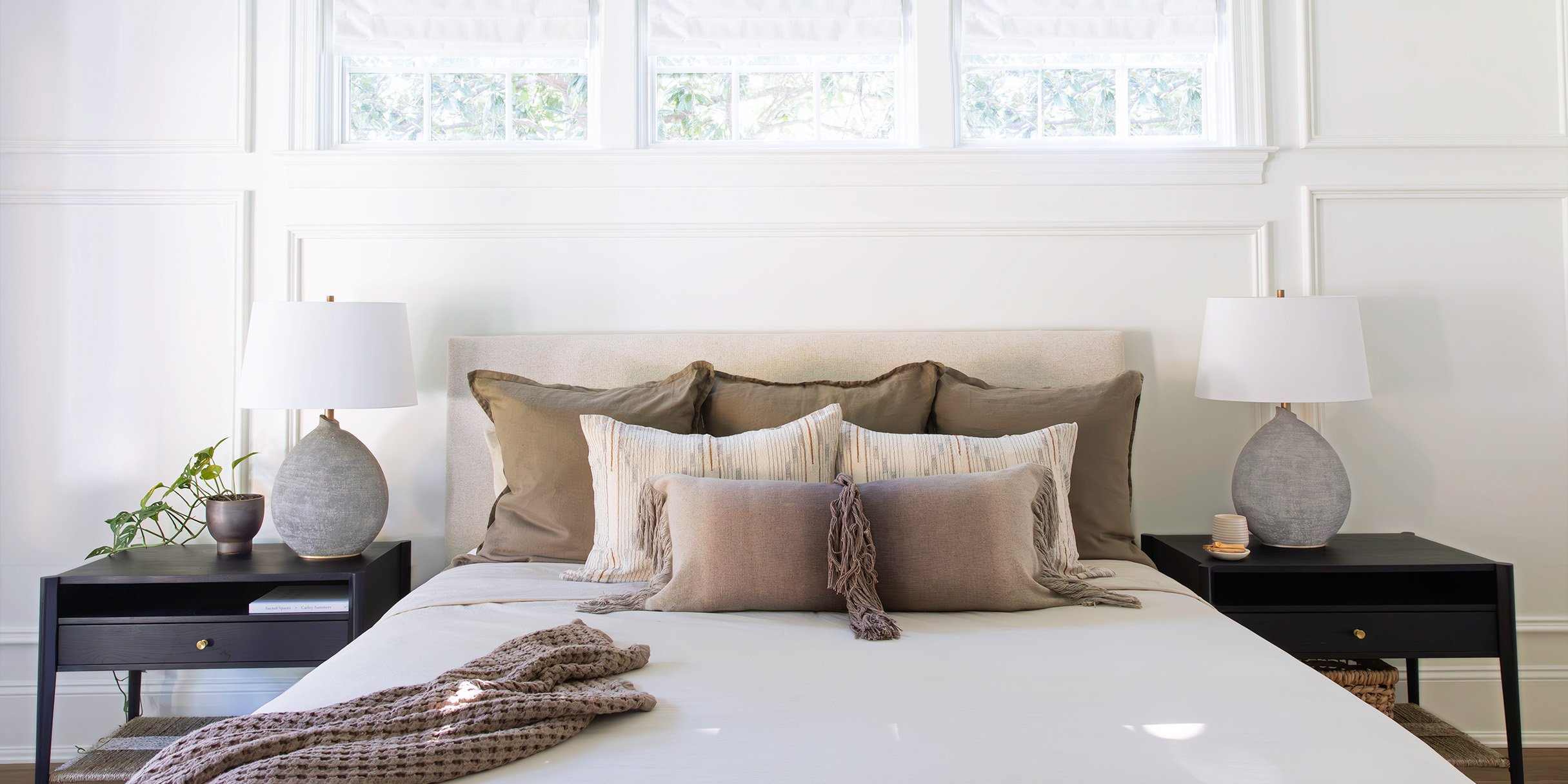New Year, Better Sleep
Understanding Sleep vs. Rest
Bedroom Design by Orshi Wren of Astral House Mindful Interior Design
To truly comprehend the essence of rest, delving into the intricacies of sleep stages is crucial. Sleep is a dynamic process encompassing various stages, with REM (Rapid Eye Movement) and NREM (Non-Rapid Eye Movement) being primary. REM sleep is associated with vivid dreams and cognitive restoration, while NREM is a deeper, more physically restorative phase. Understanding the interplay of these stages provides insights into how each contributes to waking up feeling truly rested.
Factors Influencing True Restfulness
Beyond the conventional focus on sleep duration, achieving genuine restfulness involves a nuanced consideration of sleep quality, depth, and sensation upon waking. Quality sleep involves the proper progression through sleep cycles, emphasizing the importance of undisturbed rest. Factors like sleep environment, stress levels, and lifestyle choices significantly influence the overall sense of restfulness upon waking, extending the discussion beyond mere sleep duration.
Hertz Frequencies for Sleep
Harnessing the power of sound, particularly specific hertz frequencies emerges as a valuable tool for enhancing sleep. Binaural beats, a form of auditory illusion, synchronize with brainwaves, promoting relaxation and sleep induction. Exploring the science behind these frequencies provides a holistic understanding of how sound can be utilized as a potent tool in the pursuit of improved sleep quality. Delta waves, ranging from 0.5 to 4 hertz, are associated with deep sleep and restoration. Theta waves, between 4 and 8 hertz, are linked to light sleep and the early stages of relaxation. For those seeking a meditative state, alpha waves, from 8 to 14 hertz, are beneficial. Meanwhile, beta waves, above 14 hertz, are connected to alertness and wakefulness.B. Banishing
Technology's Impact on Sleep
In the modern age, technology's pervasive influence poses challenges to healthy sleep patterns, primarily through exposure to blue light emitted by devices. Recognizing this impact, adopting strategies to limit blue light exposure before bedtime becomes imperative. These strategies, including the use of blue light filters and reduced screen time, empower individuals to mitigate the disruptive effects of technology on their sleep.
Creating the Ideal Sleep Environment
Optimal sleep goes beyond psychological factors, extending to the physical sleep environment. Temperature regulation plays a pivotal role in achieving the ideal sleep setting. Balancing room temperature and investing in temperature-regulating bed linens contribute to a sleep-conducive atmosphere, ensuring that the body can smoothly transition into restful sleep.
Journaling, Aromatherapy, and Relaxation Techniques
Establishing calming pre-bed rituals is a cornerstone of fostering improved sleep. Journaling, as a cognitive decluttering practice, aids in calming the mind. Aromatherapy, particularly with scents like lavender, has proven relaxation benefits. Incorporating these rituals, along with soothing baths, into a consistent bedtime routine signals to the body that it's time to unwind, enhancing the overall sleep experience.
Designing for Rest
Bedroom Design by Orshi Wren of Astral House Mindful Interior Design
In the realm of mindful interior design, Orshi Wren of Astral House has been redefining spaces with a keen focus on enhancing well-being in the Tampa Bay and St. Petersburg areas of Florida. Applying the principles of Feng Shui, they emphasize the importance of clutter-free zones for promoting optimal rest. Through minimalism and thoughtful organization, Astral House creates tranquil sleep spaces that transcend mere aesthetics, fostering an atmosphere conducive to relaxation and rejuvenation. When it comes to bedding, Astral House stands out as a top interior designer, curating bedding bliss with a careful selection of sheets and pillows
“When the room is organized and free from unnecessary items, the mind can unwind more easily, promoting a sense of calmness that is conducive to restful sleep. Minimalistic design, incorporating only essential and aesthetically pleasing elements, can transform the bedroom into a sanctuary where the mind finds peace.” - Orshi Wren
Sheets and Pillows for Optimal Comfort
Choosing the right bedding is paramount for creating a sleep haven. Optimal comfort is achieved through high-quality sheets and pillows, and brands like Parachute, Cozy Earth, and Citizenry are known for providing luxurious and comfortable options. The use of temperature-regulating linens contributes to a comfortable sleeping environment, ensuring that the bed becomes a cocoon of relaxation. By investing in top-tier bedding, individuals can elevate their sleep experience, enjoying both style and substance in the bedroom.
Plants, Air Quality, and Sleep
Integrating plants into the bedroom goes beyond aesthetics; it can significantly impact air quality and contribute to better sleep. Selecting bedroom plants known for their air-purifying qualities, such as snake plants, peace lilies, or aloe vera, promotes a healthier breathing environment. Improved air quality translates to a more serene atmosphere, supporting the body's natural rhythm for rest. Greenery in the bedroom aligns with the principles of biophilic design, connecting individuals with nature even in indoor spaces, fostering a sense of tranquility essential for a good night's sleep.
Sleep Trends for 2024
As we step into 2024, the landscape of sleep science continues to evolve, offering exciting prospects for enhanced sleep quality. Advances in sleep research delve deeper into understanding the intricacies of sleep cycles, exploring the intersections of sleep and overall well-being. The practical implications of these discoveries are expected to guide individuals toward more personalized sleep solutions, emphasizing not only the duration but the quality and depth of sleep. The emerging trends in sleep science reflect a holistic approach to well-being, acknowledging the profound impact of rest on physical and mental health.
Anticipated Sleep-Enhancing Technologies
The trajectory of sleep-enhancing technologies takes a futuristic turn in 2024, presenting tools that promise to revolutionize the way we approach sleep. Innovations such as smart mattresses that adjust firmness based on sleep patterns, advanced sleep trackers with real-time analysis, and AI-powered sleep coaching applications are on the horizon. These technologies aim to provide a comprehensive understanding of individual sleep needs and offer tailored interventions to optimize sleep quality. As we anticipate these advancements, the integration of technology into the sleep routine is poised to become more intuitive and personalized, catering to the unique requirements of each sleeper.



